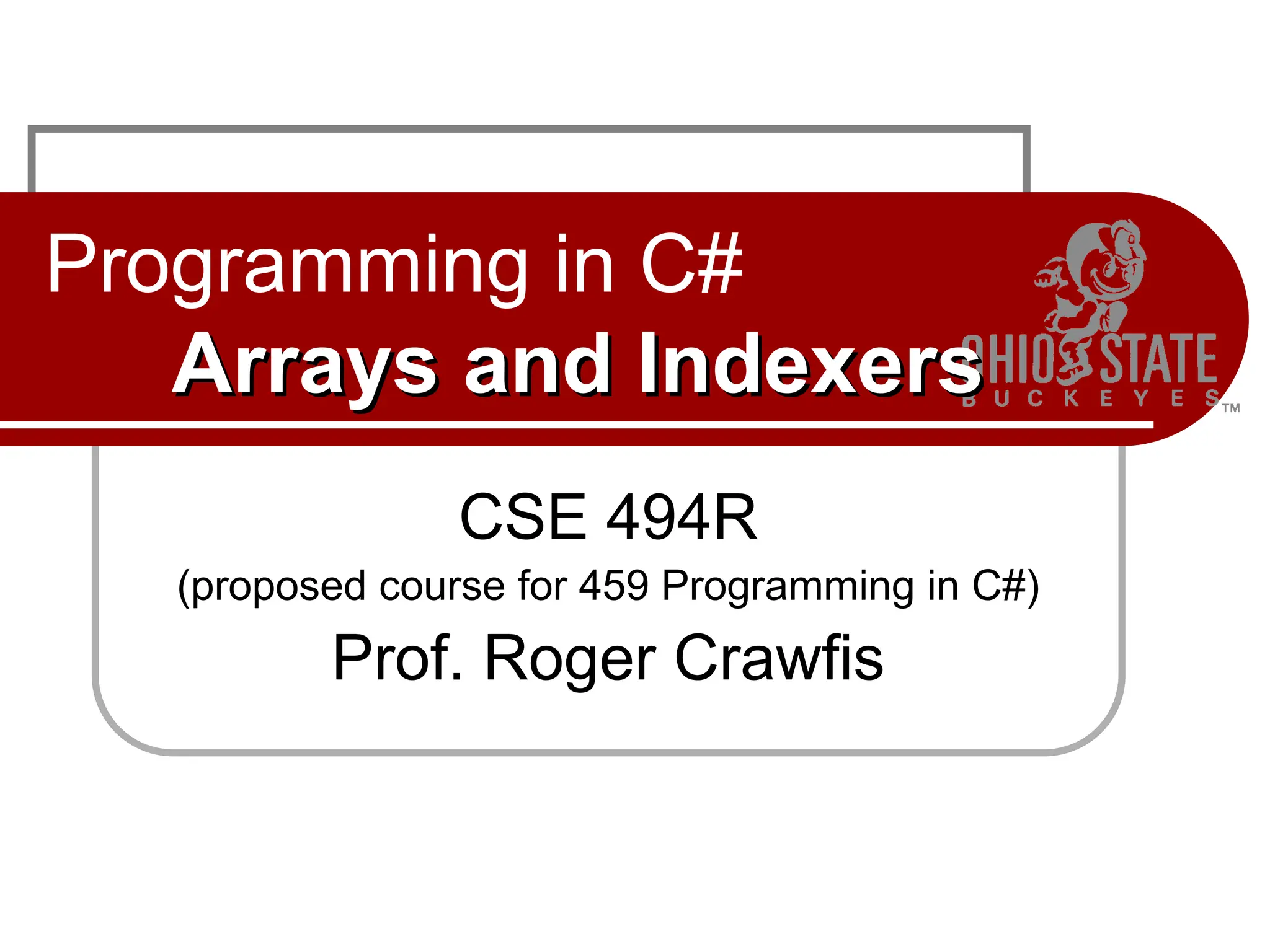The document discusses arrays and indexers in C#, detailing the strict declaration and bounds checking of arrays, along with the concept of jagged and multi-dimensional arrays. It describes how C# allows for true multi-dimensional arrays, array initialization, and the usage of indexers for enabling bracket notation on objects. Additionally, it explains how indexers allow instances to behave like virtual arrays and can be defined with different access levels.

![Array Declarations
An array is an object (not just a stream of
objects). See System.Array.
Bounds checking is performed for all access
attempts.
Declaration similar to Java, but more strict.
Type definition: a is a “1D array of int’s”
Instance specifics: a is equal to a 1D array of int’s
of size 10.
int[] a = new int[10];
int[] b = a;
int[] c = new int[3] {1,2,3};
int[] d = {1,2,3,4};](https://image.slidesharecdn.com/cse459csharp02arrays-240922063020-cc83cd48/75/CSharp_02_Arrays_fundamentals_concepts_introduction-2-2048.jpg)
![Jagged Arrays
Can have standard C-style jagged arrays
int[] array = new int[30];
int[][] array = new int[2][];
array[0] = new int[100];
array[1] = new int[1];
Stored in random parts of the heap
Stored in row major order](https://image.slidesharecdn.com/cse459csharp02arrays-240922063020-cc83cd48/75/CSharp_02_Arrays_fundamentals_concepts_introduction-3-2048.jpg)
![C# Arrays
Multi-dimensional arrays are jagged arrays
with a user-enforced constraint in C.
Really just 1D arrays, but each element can contain
a 1D array (recursion).
C# provides true multi-dimensional arrays
Elements are stored sequentially
CLR (JIT compiler) computes the offset code
int[,] array = new int[10,30];
array[3,7] = 137;
int[,] arr4 = new int [2,3] { {1,2,3}, {4,5,6} };
int[,] arr5 = new int [,] { {1,2,3}, {4,5,6} };
int[,] arr6 = { {1,2,3}, {4,5,6} };](https://image.slidesharecdn.com/cse459csharp02arrays-240922063020-cc83cd48/75/CSharp_02_Arrays_fundamentals_concepts_introduction-4-2048.jpg)
![Indexers
Allow bracket notation on any object
public string this[int a, double b]
{ … }
Related to C++ operator[ ] overloading
Special property](https://image.slidesharecdn.com/cse459csharp02arrays-240922063020-cc83cd48/75/CSharp_02_Arrays_fundamentals_concepts_introduction-5-2048.jpg)
![public class ListBox: Control {
private string[] items;
public string this[int index] {
get { return items[index]; }
set { items[index] = value;
Repaint(); }
}
}
ListBox listBox = new ListBox();
listBox[0] = "hello";
Console.WriteLine(listBox[0]);
Indexers
Lets an instance behave as a virtual array
Can be overloaded
Can be read-only, write-only, or read/write](https://image.slidesharecdn.com/cse459csharp02arrays-240922063020-cc83cd48/75/CSharp_02_Arrays_fundamentals_concepts_introduction-6-2048.jpg)